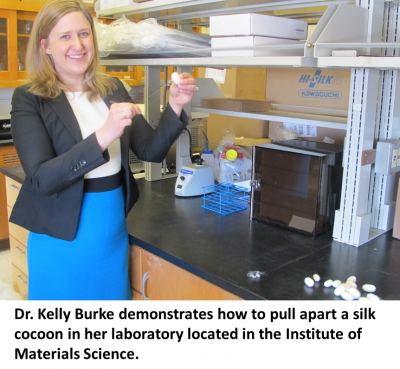By Sydney Souder
D r. Radenka Maric, Connecticut Clean Energy Professor in Sustainable Energy in the Department of Chemical & Biomolecular Engineering, was honored with the Research Innovation & Leadership Award at the Women of Innovation awards ceremony on April 1, 2015.
r. Radenka Maric, Connecticut Clean Energy Professor in Sustainable Energy in the Department of Chemical & Biomolecular Engineering, was honored with the Research Innovation & Leadership Award at the Women of Innovation awards ceremony on April 1, 2015.
Fifty-six finalists were honored for their innovation and leadership at the Connecticut Technology Council’s eleventh annual celebration. The Women of Innovation awards gala recognizes women accomplished in science, technology, engineering, math, and also involved in their community. The event allows like-minded, successful women to celebrate their accomplishments together.
 Ten of the finalists were announced as award winners during the event. Winners were chosen in eight categories. The Research Innovation & Leadership Award won by Dr. Maric is presented to a woman who has developed new knowledge or products, or improvements to products in a corporate or academic setting through original approaches to research. The Research Innovation and Leadership recipient also exhibits leadership ability by leading research teams, motivating staff and securing funding or resources to enable her research program.
Ten of the finalists were announced as award winners during the event. Winners were chosen in eight categories. The Research Innovation & Leadership Award won by Dr. Maric is presented to a woman who has developed new knowledge or products, or improvements to products in a corporate or academic setting through original approaches to research. The Research Innovation and Leadership recipient also exhibits leadership ability by leading research teams, motivating staff and securing funding or resources to enable her research program.
Dr. Maric’s research innovation and leadership is remarkable. She is internationally recognized for her contributions in sustainable energy technologies supporting the development of efficient, fuel cell-powered vehicles; nanomaterials; and manufacturability. Dr. Maric’s research interests include: synthesis of nanomaterials, unique new materials and associated processes, catalysis, kinetics, electrochemical cell design and architecture, new analytical and diagnostic techniques, fuel cell and battery systems, alternative electrochemical fuels and reactant modification, hydrogen production and storage, and sensor technology.
“I look forward to continuing my work in research, teaching, and outreach here at the University of Connecticut,” says Dr. Maric.


 The Board of Directors of the American Institute of Chemical Engineers has elected
The Board of Directors of the American Institute of Chemical Engineers has elected 
 Dr. Yongku Cho, Assistant Professor in the Department of Chemical and Biomolecular Engineering, has received a prestigious and highly competitive
Dr. Yongku Cho, Assistant Professor in the Department of Chemical and Biomolecular Engineering, has received a prestigious and highly competitive  critical backing to enable him to collect pilot data for his innovative ideas. His grant will support Dr. Cho’s research group to develop a novel approach for rapid and reversible knockout of target genes. His group will research which regulated protein levels affect brain circuits. They will specifically study the mechanism of GABAA receptor dysfunction. Deficits in GABAA receptor function have been linked to multiple neurological and psychiatric disorders, such as epilepsy and schizophrenia. With his new technique, he intends to study the role of GABAA receptor interacting proteins, which may lead to therapeutic targets for such diseases.
critical backing to enable him to collect pilot data for his innovative ideas. His grant will support Dr. Cho’s research group to develop a novel approach for rapid and reversible knockout of target genes. His group will research which regulated protein levels affect brain circuits. They will specifically study the mechanism of GABAA receptor dysfunction. Deficits in GABAA receptor function have been linked to multiple neurological and psychiatric disorders, such as epilepsy and schizophrenia. With his new technique, he intends to study the role of GABAA receptor interacting proteins, which may lead to therapeutic targets for such diseases. research at Wisconsin, Dr. Cho is now interested in manipulating these proteins to include new functions. “The broader objective of the work is to engineer antibodies with useful functionalities that they normally would not have,” says Dr. Cho.
research at Wisconsin, Dr. Cho is now interested in manipulating these proteins to include new functions. “The broader objective of the work is to engineer antibodies with useful functionalities that they normally would not have,” says Dr. Cho. Dr. Yu Lei, Associate Professor of Chemical and Biomolecular Engineering at the University of Connecticut, received a US Patent for his explosive detection technology.
Dr. Yu Lei, Associate Professor of Chemical and Biomolecular Engineering at the University of Connecticut, received a US Patent for his explosive detection technology.




